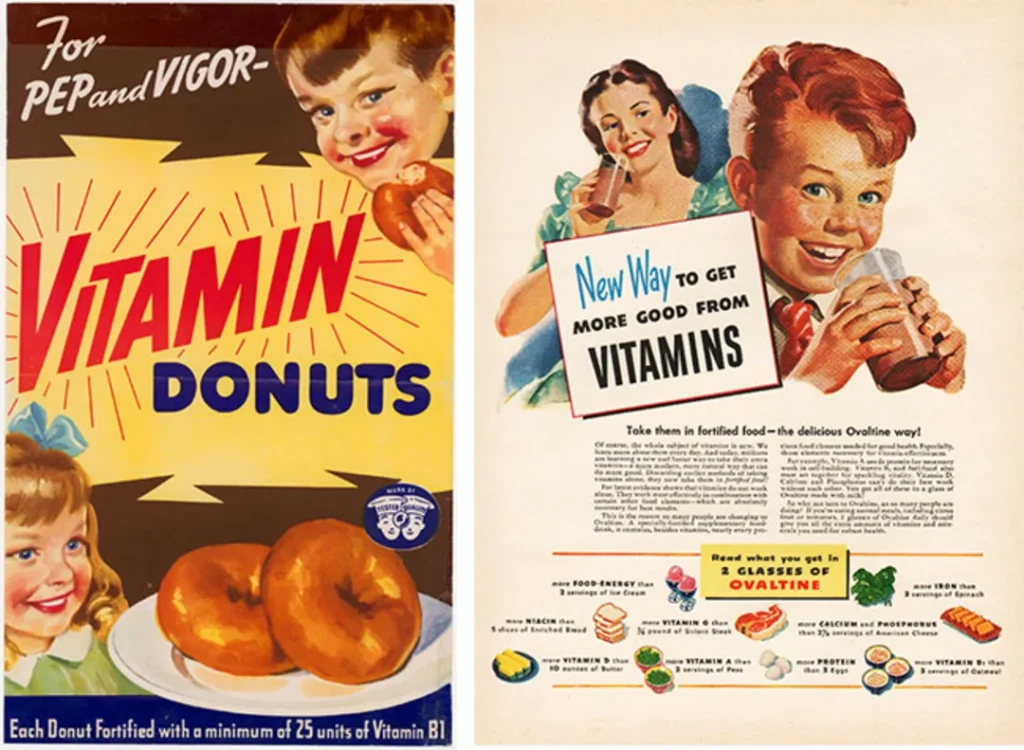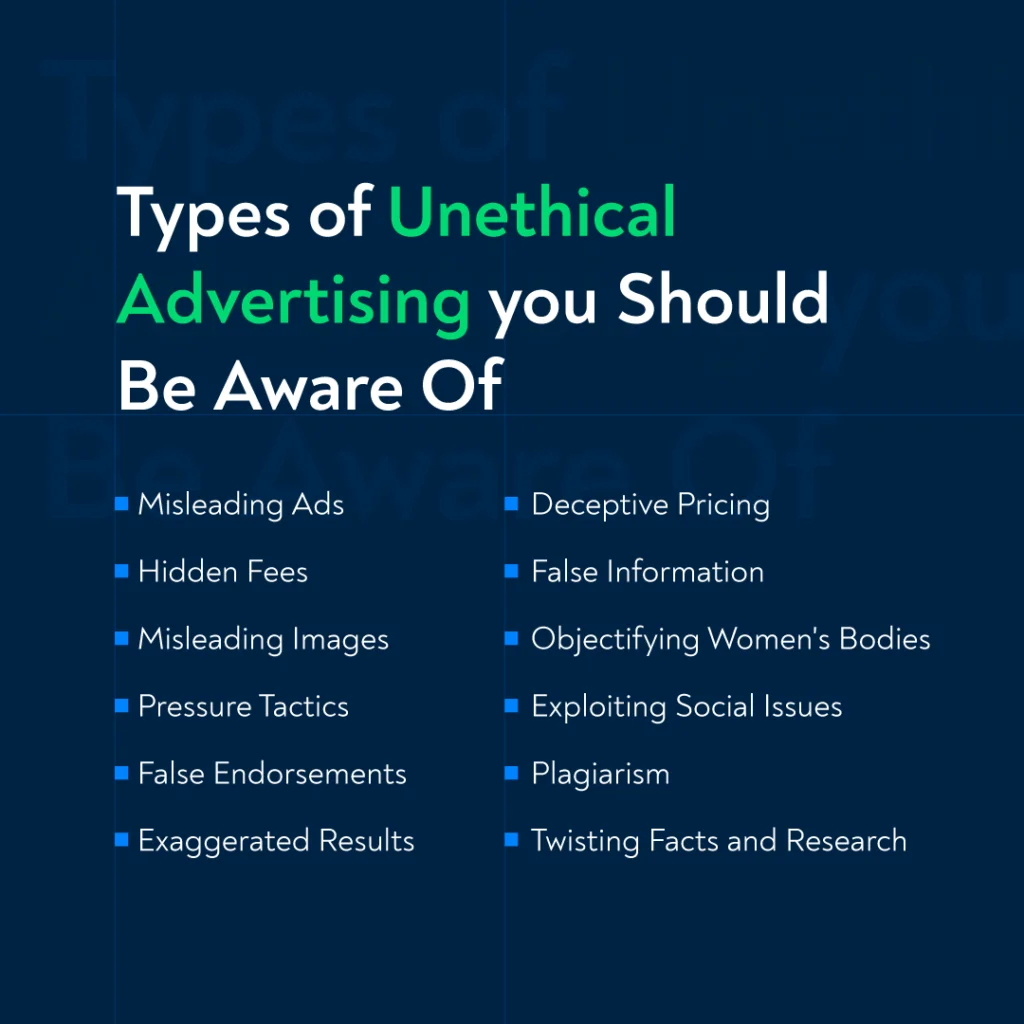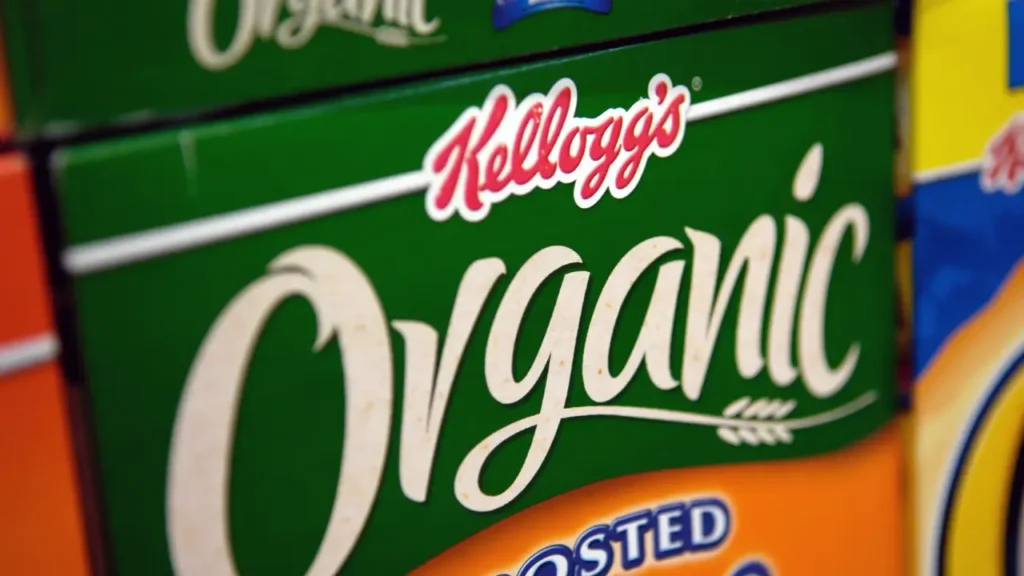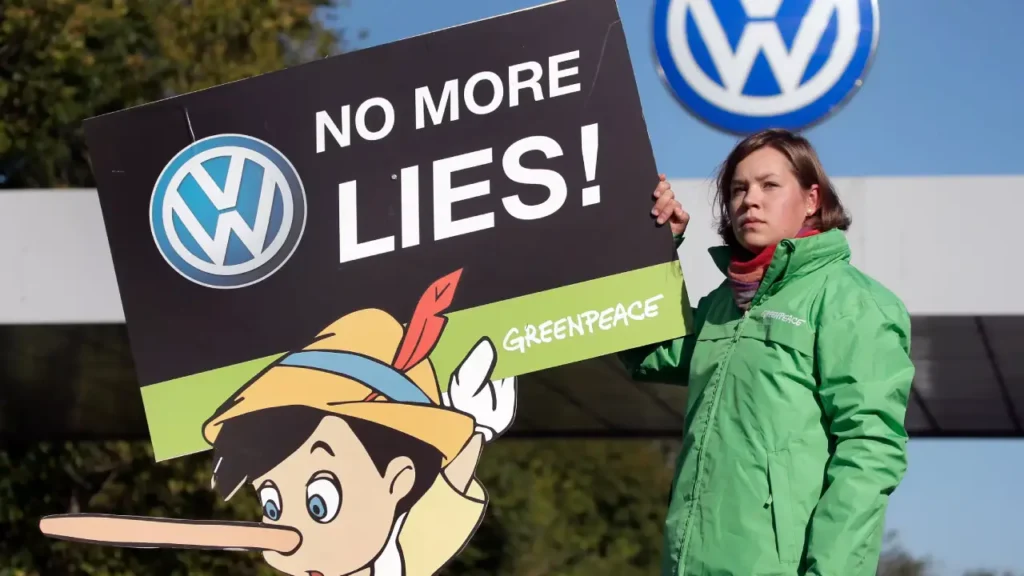False Advertising: Deceitfully Promoting Products and Services
False advertising uses false, misleading, or unsubstantiated claims to promote a product, service, or brand. It involves exaggerating the benefits or features of a product to get consumers to buy it. False advertising is rampant across industries and mediums, from print ads to social media influencers. Understanding false advertising, its origins, and problems and recognising deceptive marketing practices empower consumers to make informed decisions and hold advertisers accountable.
Table of Contents
What is False Advertising?

False advertising is deceptive marketing practices that overpromise what a product or service can deliver. It relies on unproven claims, exaggerated benefits, misleading comparisons with competitors, and omitting important facts that deceive consumers.
Some examples of false advertising include:
- Claiming a product provides benefits or features, it does not have—for instance, listing unused ingredients or promoting unsubstantiated health claims.
- It makes exaggerated claims about a product's performance, durability, speed, longevity or other characteristics that cannot be supported.
- They are quoting high prices as the “regular price” to make a discount seem like a bargain when the regular price is inflated and unrealistic.
- Using manipulative “before and after” images to promote a product's effectiveness by misleading viewers about the actual results.
- Falsely claiming a product is endorsed by experts, celebrities, government agencies or independent testing when it is not.
- They promote a product as “new and improved” when no significant changes have been made.
- Stating that a product is made in one country when made elsewhere.
- It is advertising a product as “eco-friendly” or “all-natural” when it does not meet standards to make those claims.
Any promotion that deceives potential customers is considered false advertising if it influences purchasing decisions. This deceptive marketing violates consumer protection laws in many countries.
History and Evolution of False Advertising

False and exaggerated claims in advertising are nearly as old as advertising itself. As mass media grew in the late 1800s and early 1900s, some manufacturers began making doubtful health claims about their “patent medicines.” This led to the first regulations on false advertising.
The rise of national advertising in newspapers and magazines in the 1920s let advertisers promote products to wider audiences. However, there were still no laws to protect consumers from misleading claims.
By the 1930s, radio allowed advertisers even greater reach. Lack of regulation resulted in outlandish and unsubstantiated product claims over the airwaves. The expansion of advertising on the new medium of television in the 1950s and 1960s pushed the rise of consumerism and a need for ad regulations.
In the U.S., the Federal Trade Commission (FTC) began enforcing laws prohibiting unfair or deceptive advertising in the 1970s. The FTC's truth-in-advertising laws form the basis for regulations in other countries. However, as technology and new advertising formats arise, deceptive marketers find ways to promote products without technically lying.
For instance, non-specific superlatives like “best” or “leading” brands let advertisers make claims without concrete facts. Social media influencers may fail to disclose they are paid sponsors. Search ads can use manipulative keywords to imply relevance falsely. Website “comparison reviews” and testimonials often fail to substantiate claims.
Staying ahead of overly creative marketers requires constant vigilance by both regulators and consumers.
Common Types of False Advertising

False advertising comes in many forms, but some of the most common deceptive practices involve:
Misleading Pricing Offers
- Using a fake “regular” price much higher than the standard retail price so that a discounted price seems like a bargain
- Advertising low monthly payment amounts without clearly disclosing total costs, including interest and fees
- Offering a short-term teaser rate and then drastically increasing prices
Unsubstantiated Product Claims
- Promoting health benefits, performance capabilities or features that the product does not offer
- Using vague, non-specific claims like “best-selling” without proof or context
- Claiming clinical proof without qualified scientific evidence
Deceptive Before-and-After Representations
- Showing atypical, best-case results from using a product without the typical results
- Altering “before” images to falsely imply a considerable change after use
- Failing to disclose if images were retouched or not actual customers
Fake Experts and Endorsements
- Quoting doctors, professors or experts who were paid to give testimonials or do not exist
- Falsely claiming a celebrity-endorsed a product
- Using fake user reviews and testimonials from fictional people
Manipulative Imagery and Packaging
- Depicting more or more oversized products than actually inside the package
- Using images of premium ingredients that are not included
- Showing a competitor's product and claiming it is theirs
Omission of Important Facts
- Hiding that a spokesperson was paid for their endorsement
- Not revealing recurring monthly costs in large print
- Failing to state geographic or other restrictions on an offer
These tactics take advantage of the fact that consumers cannot see, touch or test products from an advertisement the way they can in a store. By evoking solid emotions like fear, humour or sexual attraction, deceptive ads can overcome consumer logic.
Problems and Effects Caused by False Advertising

False advertising might seem a harmless exaggeration, but it can cause serious problems for consumers and the market, including:
Decreased Buyer Trust
- Repeated exposure to over-hyped products breeds scepticism about all advertising claims.
- Misleading claims corrode brand reputations and loyalty
Financial Harm to Consumers
- Buyers waste money on products that do not work as advertised
- Hidden recurring costs can saddle consumers with expensive subscriptions
- Low-quality products need frequent replacement compared to durable options
Uninformed Purchasing Decisions
- Deceptive claims prevent consumers from rationally comparing products on merit.
- The omission of negatives hides potential downsides or risks from buyers
- Vague superlatives like “best” or “most powerful” are meaningless without context
Anti-Competitive Markets
- Dishonest comparisons with rivals damage fair competition
- False claims allow inferior products to gain market share
- Startups and honest advertisers struggle with established brands using deceptive messaging
Health and Safety Dangers
- Exaggerating the benefits of supplements, drugs, or medical equipment can endanger lives.
- Masking the country of origin hides safety standards and recalls from consumers.
Environmental Harm
- Misleading sustainability and “greenwashing” claims hide the actual ecological impact.
The cumulative effects of false advertising undermine efficient markets, consumer education and ethical business conduct. That makes cracking down on deceptive marketing a priority.
Recognising False Advertising Red Flags

Since advertisers invest enormous resources to toe the line between effective persuasion and outright deception, consumers must watch for red flags that indicate misleading claims.
Be sceptical of ads that:
- Use exaggerated language like “magical,” “miraculous” or “unbelievable” without concrete supporting evidence
- Have unverifiable patient testimonials but no scientific clinical proof
- Offer excellent results in unrealistic or very short timeframes
- Show unlikely perfect “before and after” transformations from real users
- Feature paid celebrity sponsors or influencers without clearly disclosing that fact
- Use fake badges like “#1 Doctor Recommended” or “As Seen On TV” designed to look like quality seals
- Bury important disclaimers, exclusions and side effects in tiny, fast-moving fine print
- Fail to substantiate vague claims of being the “best,” “most powerful,” “leading” or “top-rated” brand
- Hide recurring monthly fees and actual total costs in small text or voiceovers
- Base comparisons only on cherry-picked features where they have an advantage while ignoring downsides
- Are full of logical fallacies, unsubstantiated assumptions and emotion-laden language but lack facts
- Come from brands running short-term, constantly changing promos instead of consistent value
With vigilance, consumers can see through the hype and make informed product decisions. However, legal efforts and public pressure are still required to protect shoppers fully by banning deceptive advertising.
Efforts to Counter False Advertising
Progress has been made in monitoring and enforcing laws against false advertising, including:
- Truth-in-Advertising Laws: The FTC legally defines and prohibits unfair or deceptive practices, enforced with fines reaching millions of dollars—similar laws enacted globally.
- Industry Self-Regulation: Advertising trade groups like the BBB National Programs create standards and policies to avoid government intervention. Offenders can be expelled.
- Pre-Release Substantiation: Regulators require advertisers to prove claims upfront for products like drugs with potential health risks rather than after complaints.
- Disclosure Statements: Requiring influencers, sponsored content and testimonials to state they are paid promotions explicitly.
- Consumers and Watchdogs: Advocacy groups like TruthInAdvertising.org and changing public attitudes are putting pressure on brands and regulators to act.
- Ad Monitoring: Authorities actively scan for and pull deceptive ads on websites, social media, TV and radio rather than just responding to complaints.
- Class Action Lawsuits: Consumers joining together in lawsuits punish brands and deter others from similar deception. Brands can be liable for millions in damages.
- Competitor Lawsuits: Brands increasingly take rivals to court over deceptive comparative advertising to level the playing field.
- Ad Tech Improvements: Better targeting and analytics help digital platforms filter out fraudsters and incentivise authentic content.
- Consumer Awareness: Widespread education on false advertising tactics through journalism and social media empowers buyers.
Despite significant progress, the evolving digital landscape enables new forms of deception. All stakeholders must be vigilant to ensure consumers are not exploited.
Avoiding the Harms of False Advertising

Savvy consumers can protect themselves from the impacts of deceptive advertising by:
- Searching for in-depth reviews on independent testing and rating sites instead of relying only on ads.
- Check with advocacy groups to see if brands have a history of substantiated complaints.
- Looking closely at disclaimers and fine print to understand total costs and limitations.
- Fact-checking claims against competitors' stats and scientific sources rather than emotions.
- Seeking peer endorsements on social media and community forums over celebrity sponsors.
- Consulting salespeople, customer service or brand reps to clarify claims rather than just passive ads.
- Consider product samples or free trials before making significant purchases when possible.
- Avoiding impulse purchases in the heat of the moment from a persuasive ad.
- Evaluating product quality yourself over time instead of initial advertisements.
- Reporting deceptive ads to regulators, platforms, brands and advocacy groups like the Better Business Bureau.
While ads should highlight the best attributes of products, outright deception harms the entire marketplace. However, informed consumers can make better decisions.
What Can Be Done to Curb False Advertising?
While progress has been made, analysts argue modernising policies and grassroots advocacy are still needed to curb false advertising's influence:
- Close Regulatory Gaps. Laws lag behind new advertising tactics, especially “native advertising” blended with non-commercial content online.
- Increase Penalties. Some say fines for violations should be proportional to company revenues to deter large corporations.
- Improve Monitoring Technology. AI and big data analytics could help regulators identify misconduct at the massive scale of modern advertising.
- Boost Legal Access. Lowering barriers to class action lawsuits could empower consumers to hold companies accountable.
- Limit Data Use. Stricter privacy regulations could restrict how advertisers exploit consumers' data to target vulnerable individuals.
- Fund Ad Literacy Programs. Educating the public on identifying misleading claims could “inoculate” them against manipulation.
- Incentivize Ethics. Governments could award “seals of approval” or tax rebates to companies that meet ethical advertising standards.
- Encourage Industry Self-Regulation. Trade bodies and consumer watchdogs could establish stricter codes of conduct for advertisers to abide by.
False advertising erodes public trust and exploits society's most vulnerable. While stamping it out entirely may be impossible, mitigating its influence benefits consumers and businesses. With vigilance and cooperation, advertising can better live up to its potential to inform, educate and ethically persuade.
The Future of False Advertising

Evolving technology and marketing tactics will require continued upgrades to advertising regulations, monitoring methods, and consumer education. Possible directions include:
- Expanding fines and penalties to match more significant profit incentives for viral deception.
- Banning specific manipulative techniques that have proven highly deceptive across formats.
- Enacting rules tailored to digital platforms and influencer marketing versus traditional media.
- Requiring advertisers to pre-screen significant claims on high-risk products like supplements.
- Artificial intelligence is used to analyse language patterns and flag potential deception rapidly.
- Introducing minimum display time requirements for critical details like disclaimers.
- Mandating easy reporting tools and opt-outs on platforms enabling false ads.
- Producing robust consumer education through schools and public service campaigns.
- Harnessing blockchain and immutable ledgers to confirm product origins, testing, and certifications.
While the technological cat-and-mouse game continues, society's intolerance for exploitation must keep pace. Consumers can force advertisers to adhere to ethical practices focused on genuine merit versus manipulative claims through vigilance and advocacy.
Frequently Asked Questions About False Advertising
What are some of the most common examples of false advertising today?
Some of the most frequent categories of false advertising involve exaggerated product capabilities, unsupported health claims, manipulative before-and-after comparisons, fake online reviews, misleading pricing tactics and deceitful fear-based appeals.
How can I report false advertising?
In most countries, you can report deceptive ads to your consumer protection agency, advertising standards authority or the Better Business Bureau. Filing complaints helps regulators identify trends.
What are the penalties and fines for false advertising?
Regulators can impose fines ranging from tens of thousands to millions of dollars depending on the severity and past offences. Multiple infractions can lead to criminal fraud charges. Brands also often have to issue retractions.
Are there laws against all misleading advertising or only specific lies?
Laws focus on substantiated deception regarding key purchase factors like product features, pricing, endorsements, ingredients, research proof, etc. Puffery and opinion are not regulated.
How can you tell whether health claims in supplement ads are false?
Look for certified scientific research backing such as clinical drug trials, FDA approval and publication in accredited medical journals. Be sceptical of generic claims referencing studies without specifics cited.
Conclusion
In summary, false advertising remains a prevalent issue eroding consumer trust and efficient markets. Recognising deceptive advertising tactics empowers the public to make intelligent choices and demand higher brand standards. With continued pressure from government authorities, watchdog groups and consumers, unethical marketers will find it increasingly difficult to profit from manipulation. The future of advertising must focus on innovating actual product improvements and benefits versus just hype.
